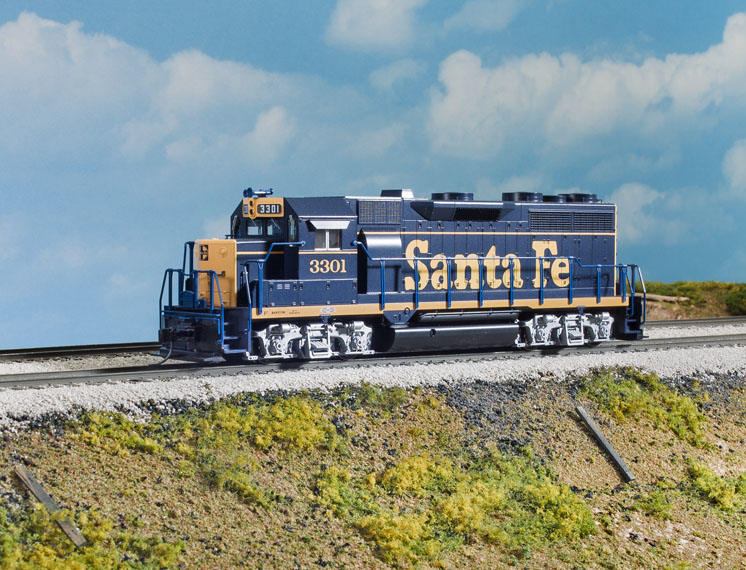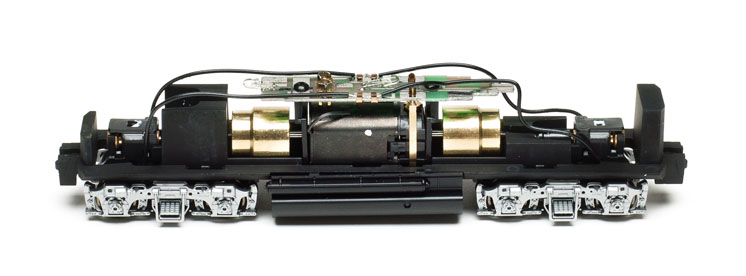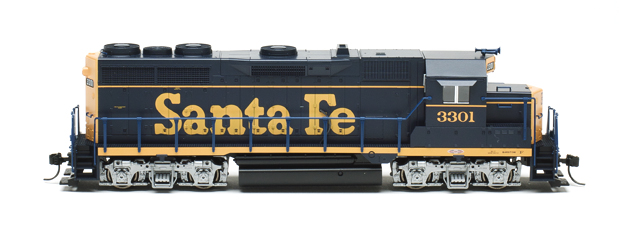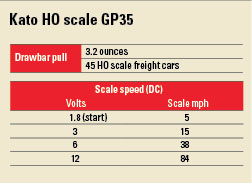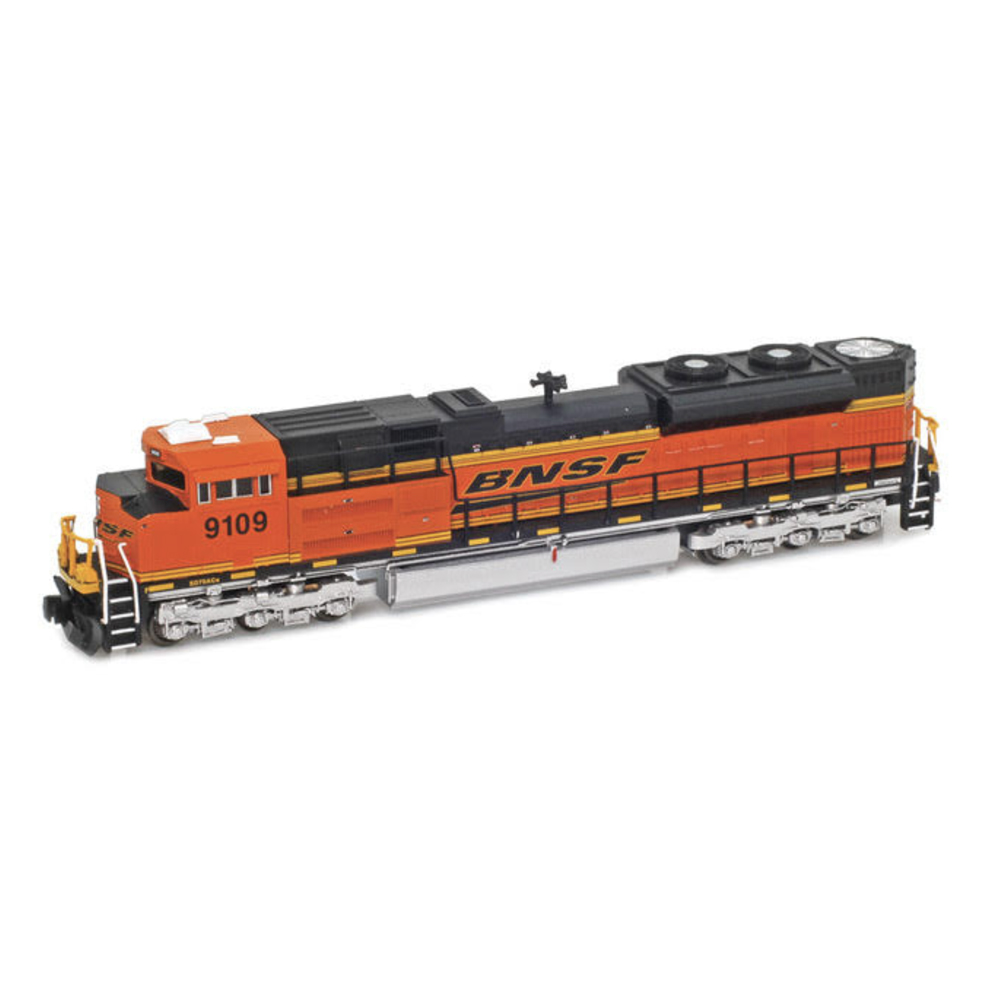After a long hiatus, the Electro-Motive Division GP35 diesel locomotive has returned to Kato’s HO scale product lineup. But this isn’t just a re-hash of the horn-hook-coupler-equipped model reviewed in the September 1992 Model Railroader. The new GP35 features Kato knuckle couplers and a printed-circuit (PC) board with an eight-pin socket for installing a Digital Command Control (DCC) decoder.
Electro-Motive Division produced the GP35 from October 1963 through January 1966. During the course of the production run 1,250 locomotives were built for railroads in the United States, and another 83 for lines in Canada in Mexico.
The Kato model is based on what railfans call the Phase Ia design, which was built from October 1963 through April 1964. Spotting features of this phase include a flat inertial filter hatch, thick side sills, clusters of three louvers on the battery box doors, seven sets of latches on the tall hood doors, and a 36″ center radiator fan with an open-top design.
Though the low-nose design was the EMD standard, the locomotive builder also built versions with high short hoods for Norfolk & Western, Southern Ry., and the National Ry. of Mexico. Chicago & North Western and St. Louis-San Francisco (Frisco) both ordered their GP35s with 3,000-gallon fuel tanks, which moved the air reservoirs to the top of the long hood. Some GP35s were built using parts from Alco trade-ins and rode on Alco trucks.
The Kato model features an injection-molded plastic shell. The long and short hoods are molded as one piece, with a separate battery box compartment, dynamic brake blister, cab, and sill.
A separate cab interior is included, but there are no crew figures. A metal weight is attached to the underside of the long hood with a Phillips screw.
For the most part, the model’s dimensions follow prototype drawings in the Model Railroader Cyclopedia, Vol. 2: Diesel Locomotives (out of print). The distance over the footboard pilots is about a scale foot too short, and the middle radiator fan is 3 scale inches too wide.
The model comes with an assortment of modeler-installed details, including handrails, number boards, an air horn, grab irons, brake cylinders, windshield wipers, m.u. cables, uncoupling levers, and swing hangers. These take a while to put on, but in the end it’s worth it.
The blue on the flexible plastic handrails and grab irons is a bit lighter than the body color, but this can be remedied by spraying or brushing the parts with paint formulated for polycarbonate radio-controlled car bodies.
Our sample is painted in Santa Fe’s 1960 pinstripe scheme. Though the prototype engine was built in March 1964, it didn’t wear the road number 3301 until 1970 when the Santa Fe did a major locomotive renumbering. The locomotive was rebuilt as a GP35u in July 1984 and renumbered 2801. The full-size locomotive operated into the second decade of the 21st century as BNSF Ry. 2501.
The blue paint is evenly applied, and the yellow is opaque. The color separation lines are also well executed. There were a few voids in the yellow Santa Fe lettering on the long hood between the engine compartment doors and in the door latches, but these could easily be touched up with paint and a fine brush.
To lift off the shell, I removed the screws and draft-gear boxes. Then I carefully squeezed the sides of the shell to disengage the retaining latches.
Underneath the shell is a die-cast metal chassis. A five-pole skew-wound motor with two brass flywheels nests in the center of the chassis and is secured from the bottom with two screws. The PC board is attached to the top of the motor with two screws. The motor drives the eight chemically blackened wheels through universal joints. As with the original run in 1992, the turned brass bell fits into a notch in the chassis and a two-piece plastic fuel tank assembly snaps around the chassis.
Kato offers its GP35 as a direct-current (DC) model and with an ESU Digital Command Control (DCC) motor-only decoder. Our sample is of the former.
I tested our model using a Model Rectifier Corp. Tech 4 MRC 200 power pack. The model crawled along at a scale 5 mph at 1.8V, and achieved a top speed of 84 scale mph. This is only 1 mph higher than the prototype’s top speed.
The GP35 has a drawbar pull of 3.2 ounces, which is equivalent to 45 freight cars on straight and level track. This is appropriate for a four-axle road switcher.
To convert a DC model to DCC, remove the dummy plugs from the eight-pin socket and install the decoder of your choice. A two-sided instruction sheet explains how to do this.
Unlike some newer Kato HO scale locomotives, the GP35 doesn’t have provisions for a speaker in the fuel tank or under the radiator fan. There’s some room above the rear truck’s gear tower for a small speaker. One or two 1⁄2″ round speakers could also fit under the rear radiator fans. However, depending on the speakers’ thickness, the rear light pipe may have to be removed.
It’s been more than two decades since Kato released its first GP35, and the new model is better than ever. With operating knuckle couplers, an eight-pin socket for converting the model to DCC, and the availability of a factory-installed DCC version, the model meets the demands of today’s modeler. Kudos to Kato for bringing back a classic locomotive.
Manufacturer
Kato USA Inc.
100 Remington Rd.
Schaumburg, IL 60173
www.katousa.com
Road names: Atchison, Topeka & Santa Fe (pinstripe scheme) and New York Central. Two road numbers per scheme.
Era: 1970 to July 1984 (as decorated)
Features
▪▪Blackened metal wheelsets, correctly gauged
▪▪Directional headlights
▪▪Dynamic or non-dynamic brake hatches to match prototype
▪▪Eight-pin socket for Digital Command Control decoder
▪▪Kato couplers, mounted at correct height
▪▪Weight: 14.4 ounces





